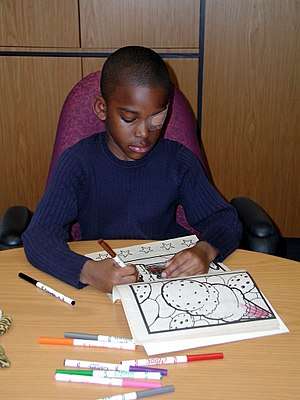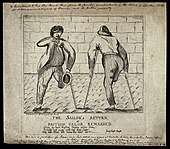Eyepatch
An eyepatch is a small patch that is worn in front of one eye. It may be a cloth patch attached around the head by an elastic band or by a string, an adhesive bandage, or a plastic device which is clipped to a pair of glasses. It is often worn by people to cover a lost or injured eye, but it also has a therapeutic use in children for the treatment of amblyopia (See orthoptics and vision therapy). Eyepatches used to block light while sleeping are referred to as a sleep mask. Eyepatches associated with pirates are a stereotype originating from fiction.
| Eyepatch | |
|---|---|
 A child wearing an adhesive eyepatch to correct amblyopia |
An eyepad or eye pad is a soft medical dressing that can be applied over an eye to protect it. It is not necessarily the same as an eyepatch.[1]
History
In the years before advanced medicine and surgery, eyepatches were common for people who had lost an eye. They were particularly prevalent among members of dangerous occupations, such as soldiers and sailors who could lose an eye in battle. While stereotypically associated with pirates, there is no evidence to suggest the historical accuracy of eye patch wearing pirates before several popular novels of the 19th century (see Pirate Eyepatches below).
Medical uses
Amblyopia
Eye patching is used in the orthoptic management[2] of children at risk of lazy eye (amblyopia), especially strabismic or anisometropic[3] amblyopia. These conditions can cause visual suppression of areas of the dissimilar images[4] by the brain such as to avoid diplopia, resulting in a loss of visual acuity in the suppressed eye and in extreme cases in blindness in an otherwise functional eye. Patching the good eye forces the amblyopic eye to function, thereby causing vision in that eye to be retained.[2][3] It is important to perform “near activities” (such as reading or handiwork) when patched, thereby exercising active, attentive vision.[5]
A study provided evidence that children treated for amblyopia with eye patching had lower self-perception of social acceptance.[6] To prevent a child from being socially marginalized by his or her peers due to wearing an eye patch, atropine eye drops may be used instead. This induces temporary blurring in the treated eye.
It has been pointed out that the penalization of one eye by means of patching or atropine drops does not provide the conditions that are necessary in order to develop or improve binocular vision. Recently, efforts have been made to propose alternative treatments of amblyopia that do allow for the improvement of binocular sight, for example using binasal occlusion or partially frosted spectacles[4] in place of any eye patch, using alternating occlusion goggles or using methods of perceptual learning based on video games or virtual reality games for enhancing binocular vision.
A 2014 Cochrane Review sought to determine the effectiveness of occlusion treatment on patients with sensory deprivation amblyopia, however no trials were found eligible to be included in the review.[7] However, it is suggested that good outcomes from occlusion treatment for sensory deprivation amblyopia rely on compliance with the treatment.
Extraocular muscle palsy
To initially relieve double vision (diplopia) caused by an extra-ocular muscle palsy, an eye care professional may recommend using an eyepatch. This can help to relieve the dizziness, vertigo and nausea that are associated with this form of double vision.[8][9][10]
Use for adaptation to dark
Pirates

Rahmah ibn Jabir al-Jalahimah, once the most popular pirate in the Persian Gulf, was also the first to wear an eyepatch after losing an eye in battle.[11][12] Although eyepatches have since become stereotypically associated with pirates, the source is unclear, and there is no historical evidence to suggest that their use was for any other reason than protecting and concealing the eye socket after the loss of an eye. Most historical depictions of seamen with eye patches are of ex-sailors, rather, than pirates.
More recent medical texts have often referred to the eye patch as a "pirate's patch" and writing in the Minnesota Academy of Sciences Journal in 1934, Charles Sheard of the Mayo foundation, pointed out that by "wearing a patch (The pirate's patch) over one eye, it will keep the covered eye in a state of readiness and adaptation for night vision".[13] This technique was explored during WWII by institutes such as the United States Navy.[14]
The proposal that pirates may have worn an eyepatch so that one eye would be pre-adjusted to below-deck darkness was tested in an episode of MythBusters in 2007 and found to be plausible, but without any recorded historical precedent.[15]
Aircraft pilots
Aircraft pilots used an eye patch, or close one eye to preserve night vision when there was disparity in the light intensity within or outside their aircraft, such as when flying at night over brightly lit cities, so that one eye could look out, and the other would be adjusted for the dim lighting of the cockpit to read unlit instruments and maps.[16] Some military pilots have worn a lead-lined or gold-lined eyepatch, to protect against blindness in both eyes, in the event of a nuclear blast or laser weapon attack.[17][18][19]
Eyepatches are not currently used by military personnel; modern technology has provided an array of other means to preserve and enhance night vision, including red-light and low-level white lights, and night vision devices.[20][21][22]
Notable eyepatch-wearers
- Sir Adrian Carton de Wiart[23]
- Ana de Mendoza[24]
- André De Toth[25]
- Andrew Vachss[26]
- Barbara Boggs Sigmund[27]
- Bobby Helms[28]
- Bruce Peterson[29]
- Bushwick Bill[30]
- Charles H. Bonesteel III[31]
- Charles Stourton, 26th Baron Mowbray[32]
- Claus von Stauffenberg[33]
- Colleen A. Harris
- Dale Chihuly[34]
- Dale D. Myers[35]
- Dan Crenshaw[36]
- Date Masamune.[37]
- David Bowie[38]
- Dick Curless[39]
- Dušan Prelević[40]
- Floyd Gibbons[41]
- Francisco de Orellana[42]
- François Coli[43]
- Fritz Lang[44]
- Gabrielle[45]
- George Maciunas[46]
- George Melly[47]
- Jack Coggins[48]
- James Joyce[38]
- Jan Syrový[49]
- Jan Zizka[50]
- John Ford[38]
- José Millán Astray[51]
- Lewis Williams Douglas
- Lisa Lopes[30]
- Luís de Camões[52]
- María de Villota[53]
- Marie Colvin
- Martin Bayerle
- Maxie Anderson[54]
- Mikhail Illarionovich Kutuzov[55]
- Momus[56]
- Moshe Dayan[38]
- Mother Angelica[57]
- Nicholas Ray[44]
- Nick Popaditch[58]
- Nicolas-Jacques Conté[59]
- Pete Burns[30]
- Peter Gatien[60]
- Rahmah ibn Jabir al-Jalahimah[61]
- Raoul Walsh[62]
- Ray Sawyer[63]
- Richard W. Rahn[64]
- Rich Williams[65]
- Ron Hamilton[66]
- Sammy Davis Jr.[38]
- Sheila Gish[67]
- Sir Francis Bryan[68]
- Slick Rick[30]
- Victor Page[69]
- Wiley Post[70]
Notable eyepatch-wearers in fiction
- Danger Mouse
- Ultimate Nick Fury
- Deathstroke
- Nick Fury Jr
- The Governor (The Walking Dead)
- Bazooka Joe
- General Chang (Star Trek VI: The Undiscovered Country)[71]
- Rooster Cogburn[72]
- Asuka Langley Soryu (Neon Genesis Evangelion)
- Elle Driver[72]
- Nick Fury[71]
- Kenpachi Zaraki (Bleach)
- Goro Majima (Yakuza)
- Franky (Sky Captain and the World of Tomorrow)[71]
- Madame Kovarian[71]
- Emilio Largo[71]
- Snake Plissken[72]
- Oberst Radl (The Eagle Has Landed)[72]
- Ribouldingue from Les Pieds Nickelés[73]
- Ziggy Stardust[74]
- Saul Tigh[71]
- Big Dan Teague (Oh Brother, Where Art Thou?)[72]
- Big Boss/Venom Snake/Solidus Snake (Metal Gear)
- Catalina Creel (Cuna de Lobos)
- Lockon Stratos (Gundam 00)
- Valmet (Jormungand)
- Ken Cosgrove (Mad Men)
- Carl Grimes (The Walking Dead)
- Sagat (Street Fighter)
- Dimitri Alexandre Blaiddyd (Fire Emblem: Three Houses)
See also
- Orthoptist
- Haploscope
- Diplopia
- Binocular vision
- Stereopsis
References
- Google search
- Georgievski Z, Koklanis K, Leone J (2007). "Orthoptists' management of amblyopia – a case based survey". Strabismus. 15 (3): 197–203. doi:10.1080/09273970701631975. PMID 18058356.
- Georgievski Z, Koklanis K, Leone J (2008). "Fixation behaviour in the treatment of amblyopia using atropine". Clinical and Experimental Ophthalmology. 36 (Suppl 2): A764–A765.
- Final Activity and Management Report Summary - SVS (Strabismus and visual suppression), CORDIS
- Birch EE (2013). "Amblyopia and binocular vision". Progress in Retinal and Eye Research (Review). 33: 67–84. doi:10.1016/j.preteyeres.2012.11.001. PMC 3577063. PMID 23201436.
- Webber AL, Wood JM, Gole GA, Brown B (November 2008). "Effect of amblyopia on self-esteem in children". Optometry and Vision Science. 85 (11): 1074–81. doi:10.1097/OPX.0b013e31818b9911. PMID 18981922.
- Antonio-Santos A, Vedula SS, Hatt RR, Powell C (2014). "Occlusion for stimulus deprivation amblyopia". Cochrane Database Syst Rev. 2 (2): CD005136. doi:10.1002/14651858.CD005136.pub3. PMC 4260153. PMID 24504975.
- O'Sullivan, S.B & Schmitz, T.J. (2007). Physical Rehabilitation. Philadelphia, PA: Davis. ISBN 978-0-8036-1247-1.
- Kernich CA (2006). "Diplopia". The Neurologist. 12 (4): 229–230. doi:10.1097/01.nrl.0000231927.93645.34. PMID 16832242.
- Edlow, Jonathan; Selim, Magdy (2010). Neurology Emergencies. Oxford University Press. ISBN 978-0-19-538858-9.
- Lampe, Christine (2010). The Book of Pirates. Gibbs Smith. p. 14. ISBN 9781423614807.
- Belgrave, Charles (1966). The Pirate Coast. George Bell & Sons. p. 122.
- Sheard, Charles (1934). "Night Vision". Minnesota Academy of Sciences Journal. 2–12: 26.
- "Night Vision". Addendum to the Handbook of the Hospital Corps, United States Navy. 1939. United States. Navy Dept. Bureau of Medicine and Surgery: A–2. 1944.
- MythBusters, episode 71
- Roy Brocklebank (2005). WORLD WAR III – The 1960s Version. Journal of Navigation, 58, pp 341-347 doi:10.1017/S0373463305003413
- Nuclear flash eye protection, Steen Hartov
- Les Frazier
- "Laser Weapons". Archived from the original on 2008-09-15. Retrieved 2008-07-24.
- Luria, S. M.; D. A. Kobus (26 April 1985). "IMMEDIATE VISIBILITY AFTER RED AND WHITE ADAPTATION" (PDF). Naval Submarine Research Laboratory. Department of the Navy. Retrieved 2011-06-01.
- "A Guide to the U. S. Naval Air Station at Vero Beach" (PDF). Indian River County Main Library. July 1999. Retrieved 2011-06-01.
- "We Own The Night". Night Vision and Electronic Sensors Directorate (NVESD). Archived from the original on 2011-05-17. Retrieved 2011-06-01.
- National Portrait Gallery
- Sightseeing Madrid - The Princess of Eboli
- The Herald - Glasgow (UK) Nov 4, 2002
- St. Louis Post Dispatch
- Los Angeles Times
- Indianapolis Star
- Bruce Peterson BioLee Majors Online
- Our favorite eyepatch heroes Maxim magazine
- Scenes from an Unfinished War: Low-Intensity Conflict in Korea, 1966–1968 Archived 2011-06-01 at the Wayback Machine by Major Daniel P. Bolger
- "Obituary: Lord Mowbray and Stourton". The Telegraph. December 14, 2006.
- Is Horrible 'Valkyrie' Tom Cruise's Nazi Apologia?Fox News
- Dale Chihuly opens Rhode Island school gallery MSNBC
- NASA Oral History TranscriptNASA
- "SNL, Pete Davidson Under Fire For Jokes About Veteran and GOP Congressional Candidate's Eye Patch". National Review.
- Sohachi Yamaoka, Date Masamune.
- Great Moments in Eye PatchesThe New York Times
- Bangor Daily News, May 26, 1995
- "Preminuo Dušan Prelević", novosti.rs
- New York Day by Day Miami Herald
- Colombia 1993 Lions Club International Amblyopia Prevention Campaign Digital Disability
- UNRAVELING THE MYSTERY OF WHITE BIRD'S FLIGHT Boston Globe Mar 8, 1987
- Scorsese's film `Journey' whirls through magnificent obsession The San Diego Union
- Dreams come true again The Herald - Glasgow (UK) Jan 31, 2000
- Fluxus Reader by Ken Friedman publisher Academy Editions ISBN 978-0-471-97858-9
- Jazz singer George Melly dies ABC News
- Ziss, Robert F. (Spring 2001). "Author-artist Jack Coggins". Historical Review of Berks County. 66 (2): 76–82. ISSN 0018-2524. OCLC 1589887. Retrieved July 13, 2009.
- Jan Syrový
- Vojenské osobnosti předválečné armády - Armádní generál Jan Syrový
- José Millán and Terreros Base documental d'Història de Catalunya Contemporary. Biografies. (1800–1931) Biografies. (1800–1931)
- Luis Vaz de Camões Catholic Encyclopedia
- Tremayne, David; Fotheringham, Alasdair (11 October 2013). "F1 driver Maria de Villota, once the 'fastest woman in sport', is found dead in Spanish hotel". The Independent. Retrieved 2 January 2018.
- The Milwaukee Journal - Jun 27, 1983
- Parkinson, Roger. The Fox of the North: The Life of Kutuzov, General of War and Peace. (London: Peter Davies, 1976), 11-17.
- Momus (April 1998). "Story Of An Eye". Retrieved 2008-05-29.
- A LIFE OF PRAYER FOR EWTN STAR STROKES BRING MOTHER ANGELICA FULL CIRCLE Saint Paul Pioneer Press - May 3, 2003
- http://www.foxnews.com/politics/2010/07/13/newspaper-apologizes-mocking-congressional-hopeful-iraq-war-injury/
- Nicolas-Jacques Conté This article incorporates text from a publication now in the public domain: Wood, James, ed. (1907). "article name needed". The Nuttall Encyclopædia. London and New York: Frederick Warne.
- The Scourge of the Pirate Coast Archived 2011-07-15 at the Wayback Machine QatarVisitor
- TV: Focus on Directors; Raoul Walsh Is Rewarding Subject in Channel 13's 'Men Who Made Movies' The New York Times
- Ray Sawyer The Spokesman-Review, Dec 22, 1978
- Richard W. Rahn, Cato Institute. Accessed December 4, 2008.
- Kansas '70s superstars lead lineup of Celebration bands By DAVID BURKE The Herald & Review August 4, 1999
- Interview with Ron Hamilton (Patch the Pirate) The Baptist Voice
- Sheila Gish Renowned British actress of stage and screen by Carole woods Herald Scotland March 14, 2005
- Weir, Henry VIII, p. 262.
- Without Bad Luck, He'd Have No Luck at All by John Branch The New York Times March 24, 2006
- POST, WILEY HARDEMAN Texas State Historical Association
- Staff (April 12, 2013). "The 8 Essential Eyepatches in Science Fiction".
- Martin Chilton (January 28, 2011). "The one-eyed legends of the big screen". The Telegraph.
- https://www.lambiek.net/artists/f/forton_louis.htm
- John Brownlee (November 1, 2016). "13 Immortal Costumes From The Closet Of David Bowie".
